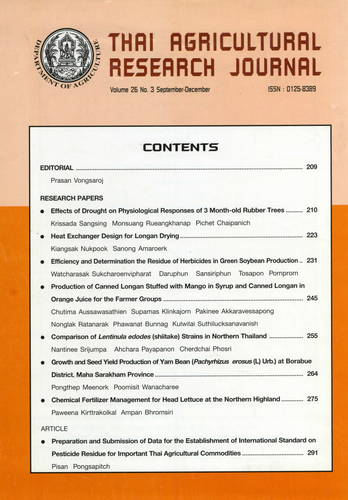Chemical Fertilizer Management for Head Lettuce in the Northern Highland
DOI:
https://doi.org/10.14456/thaidoa-agres.2008.23Keywords:
soil fertility, chemical fertilizer, head lettuce, highland soilAbstract
The research was conducted in order to evaluate the basic fertility status of the soils in vegetable cultivated areas on the highland of northern Thailand and to find out the proper chemical fertilizer management for vegetable cultivation. The studied sites were the Royal Project Development Centre at Tung Loung (TL) and farmers’ fields in June-July 2005. simple soil test kit was used for soil quality study. The results indicated that the soils had pH within the range of 4.4-7.2. The levels of organic matter content in those soils were high (>2.5%) while the levels of available P and exchangeable K were high (>40 mgP/kg, > 100 mgK/kg) to very high (>100 mgP/kg, >300 mgK/kg). Two field experiments were conducted to study the response of head lettuce at Tung Loung Centre and in the farmers’ fields during wet season. In each experiment, the experimental design was RCB with 4 replications and 5 treatments. In the first treatment, chemical fertilizers containing N, P and K were applied at the rates commonly used at the centre or by farmers. In the second, third and forth treatments, no P, K and both P and K were applied (NK, NP and N) respectively. In the fifth treatments, the fertilizer was applied according to soil analysis data and crop removal of N, P and K plus N, P and K lost by leaching about 30% of crop removal (SPA). For on –farm trial, the vegetable cultivated area in each farmer’s field was the same design as the centre. The results from both experiments indicated that SPA rate was the suitable rate for head lettuce cultivation because this rate was not different from NPK rate in terms of fresh weight yield, concentration and the total amount of N, P and K accumulated in harvested yield. The use of SPA rate could reduce the cost of input on fertilizer. Furthermore, by the SPA rate, P and K fertilizers were not applied while the amount of N fertilizer was also reduced resulting in prolonging soil degradation.
Downloads
Published
How to Cite
Issue
Section
License
Copyright (c) 2017 วารสารวิชาการเกษตร (Thai Agricultural Research Journal)

This work is licensed under a Creative Commons Attribution-NonCommercial-NoDerivatives 4.0 International License.
Thai Agricultural Research Journal



